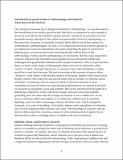Files in this item
Introduction to special section 2 : anthropology and character
Item metadata
| dc.contributor.author | Reed, Adam | |
| dc.contributor.author | Bialecki, Jon | |
| dc.date.accessioned | 2020-08-06T23:34:09Z | |
| dc.date.available | 2020-08-06T23:34:09Z | |
| dc.date.issued | 2018-08-07 | |
| dc.identifier | 253343608 | |
| dc.identifier | ed2865ab-4a7e-46ca-b711-3c905dd0d8bb | |
| dc.identifier | 85051113130 | |
| dc.identifier | 000441009600002 | |
| dc.identifier.citation | Reed , A & Bialecki , J 2018 , ' Introduction to special section 2 : anthropology and character ' , Social Anthropology , vol. 26 , no. 3 , pp. 305-313 . https://doi.org/10.1111/1469-8676.12546 | en |
| dc.identifier.issn | 0964-0282 | |
| dc.identifier.other | ORCID: /0000-0001-8917-6341/work/47356674 | |
| dc.identifier.uri | https://hdl.handle.net/10023/20420 | |
| dc.description | The authors thank The Ladislav Holy Memorial Trust for sponsoring the original Anthropology of Character conference, held at the University of St Andrews in 2016 | en |
| dc.description.abstract | The introductory essay to this second special section on Anthropology and Character seeks to extend an exploration of the relevance of the character concept, in part by looking beyond its exclusive attribution to the human subject. While continuing to develop the insights of previous discussions about both the emic and etic status of the concept, in obvious fields such as the anthropology of ethics and the anthropology of Christianity, the authors here ask what difference it makes to begin analysis with a description of non‐human characters. This includes calling our attention to the objects of character – its specific materialisations. By reflecting on various examples offered by the special section's contributors, such as the characterful nature popularly assigned to animals, to scientific units of behaviour and to historic places and buildings, new questions are identified for an emergent project on Anthropology and Character. This leads to a broader examination of characterisation as an enactment on the page (or stage) but also in the world, and on the role of audience (or reader) in the recognition of a character's distinctiveness. Finally, we ask what consequences these reflections might have for the ways in which we treat characterisation as a feature of anthropological writing. | |
| dc.format.extent | 9 | |
| dc.format.extent | 161766 | |
| dc.language.iso | eng | |
| dc.relation.ispartof | Social Anthropology | en |
| dc.subject | Non-human | en |
| dc.subject | Material culture | en |
| dc.subject | Distinctiveness | en |
| dc.subject | Literary strategy | en |
| dc.subject | Expertise | en |
| dc.subject | GN Anthropology | en |
| dc.subject | T-NDAS | en |
| dc.subject.lcc | GN | en |
| dc.title | Introduction to special section 2 : anthropology and character | en |
| dc.type | Journal article | en |
| dc.contributor.institution | University of St Andrews. Social Anthropology | en |
| dc.contributor.institution | University of St Andrews. Centre for Pacific Studies | en |
| dc.identifier.doi | 10.1111/1469-8676.12546 | |
| dc.description.status | Peer reviewed | en |
| dc.date.embargoedUntil | 2020-08-07 |
This item appears in the following Collection(s)
Items in the St Andrews Research Repository are protected by copyright, with all rights reserved, unless otherwise indicated.

